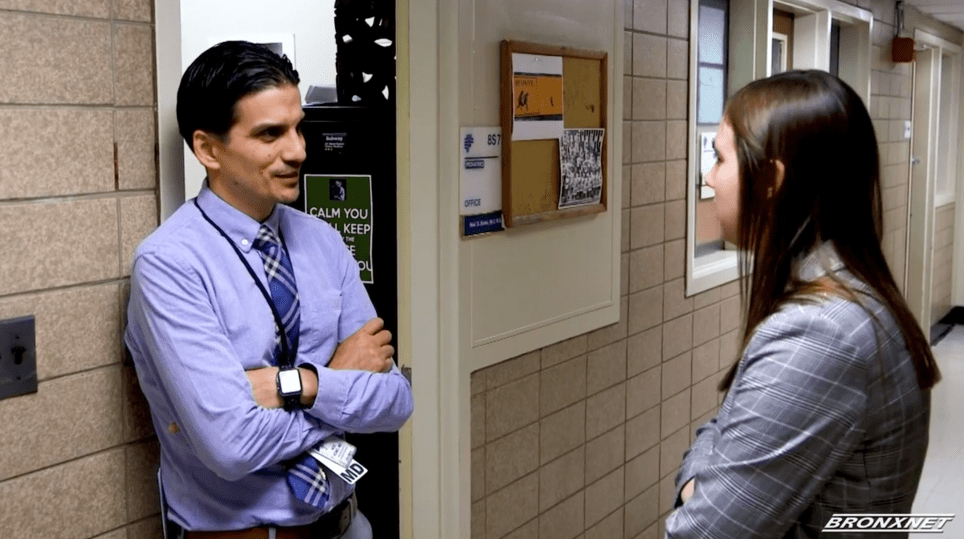Bronx Connections: Faces of Gun Violence (Part 4 of 5)

WFUV News, in partnership with The Norwood News and BronxNet Television, presents a five-part series on the impact gun violence has had on Bronx neighborhoods and the people who live in them.
The Cure to Gun Violence? Treat it Like a Disease
At Jacobi Medical Center, health professionals and community members are teaming up to combat gun violence, adopting a method akin to fighting an infectious disease.
It’s where Dr. Noe Romo, director of Pediatric Inpatient Services at the hospital who doubles as medical director for Stand Up to Violence program, comes in.
The program, which has spread across parts of the Bronx since it began in 2014, utilizes so-called violence interrupters—the equivalent to an antidote—to serve as mentors to gunshot victims who may be spurred to retaliation that could get them, or others, killed.
“We are using them as essentially mentors to mentor our patients in the hospital when they come in to try to prevent retaliation, counsel against re-injury, and figure out the factors that led to their injury,” said Romo.
The heavy involvement from neighborhood leaders coupled with the strong support, has allowed Stand Up to Violence to flourish, coinciding with a drop in shootings in areas it serves. Romo, though, isn’t resting on the Program’s laurels.
“As long as there is a single shooting, then we [Stand Up to Violence] haven’t fulfilled our purpose,” said Romo, adding there is still work to be done as long as community members continue to suffer from violence-related injuries.
For Romo, the prospect of seeing fewer shootings is personal.
Growing up in East Los Angeles exposed Romo to the effects of gun violence at an early age, which had a significant impact on his career trajectory after moving to the East Coast. After receiving his medical degree at the Albert Einstein College of Medicine, Romo completed his residency up the road at Jacobi Medical Center.
With its designation as a Level 1 Trauma Center, handling the most severe emergency cases that include gunshot wounds, Romo said he found himself as the “physician taking care of the patients who were injured, either shot, stabbed, or assaulted, as opposed to being the family member or the community member who had been the witness or who had experienced that same violent trauma.”
Witnessing the realities of gun violence and its devastating effects on the overall community served as the main inspiration for Romo and his colleagues in the trauma surgery, social work, surgery, and pediatrics and emergency medicine departments at Jacobi Medical Center to develop the program that not only treats immediate wounds, but addresses the underlying issues that lead to these acts of violence.
“This program kind of came out of [these departments] … to kind of come up with a sense of how can we address violence like a disease. And how can we have a hospital-based intervention that also has a foot in the door in the community?” said Romo. “We decided to start the Stand Up to Violence program as what we were calling a hospital-based, community violence prevention model.”
Under the program, patients undergo what Romo called a “three-pronged approach” to their care to establish a holistic picture of the incident and take the necessary steps to keep another violence-related incident from occurring.
“If there is a patient who comes in who is shot, stabbed, or assaulted, we are notified of that particular incident … I respond, along with our social worker, who is our program director, and also with our outreach worker… we all see the patient together,” Romo explained. “My main job is to make sure patients and parents understand the medical issues surrounding the injury of the patient. Our social worker… her main point is supporting the family and providing any kind of services we can provide. Our hospital outreach worker’s main position is just trying to figure out exactly what happened; what were the circumstances around the injury? Do you know who did it?”
Romo’s team also delved into whether there are confirmed thoughts of retaliation, which would trigger the deployment of outreach workers to prevent the cycle of violence.
Though the majority of outreach workers is recruited through community networks, Romo said the outreach workers who have teamed up with Stand Up to Violence are sometimes former patients. “We are able to have a steady stream of people who we are mentoring and potentially identifying as potential workers,” said Romo.
Stand Up to Violence is currently implemented within three different precincts in the Bronx. Results from the time the program was created in 2014 have shown a steady drop in gun-related incidents.
“We look at community-level data, and data collected at the patient level. The areas that we serve [the 43rd, the 47th, and the 49th precincts] combined… we’ve seen a 44 percent decrease in shootings in the neighborhoods where we are present. From a hospital perspective, we have noticed that those patients that we have intervened in have three times more likelihood of coming back for their follow-up appointments, so they get better clinical care. They also have a 52 percent less chance of coming back with a re-injury within a two-year period,” said Romo. “So essentially, patients that we see are less likely to get re-injured and are more likely to be more adherent to their medical care. In the community we are seeing significant decreases in the violence… that we used to see.”
While Romo is proud of the program’s success, he said “the numbers [for the program] are great, but that number should be 100 percent, and I think there shouldn’t be a single shooting in these areas.”

